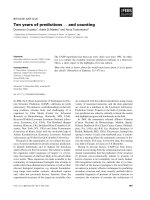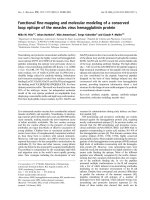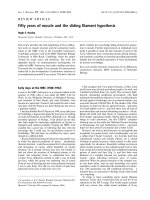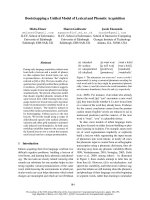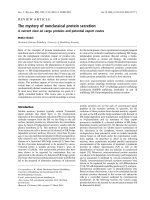200. Observing a Killer_ 25 Years of AIDS, and 25 Million Deaths pdf
Bạn đang xem bản rút gọn của tài liệu. Xem và tải ngay bản đầy đủ của tài liệu tại đây (76.13 KB, 2 trang )
Observing a Killer: 25 Years of AIDS, and 25 Million Deaths
Written by Nancy Steinbach
02 June 2006
I'm Steve Ember with IN THE NEWS in VOA Special English.
This week, the United Nations held a high-level meeting to discuss progress against AIDS and to set
new goals for the future. The three-day meeting in New York ended Friday. It marked twenty-five
years since public health officials in the United States reported the first cases of AIDS.
A new U.N. report says the AIDS epidemic appears to be slowing down in its worldwide spread. But
new infections continue to increase in some areas and countries. The report says India now has the
largest number of H.I.V. infections, but Africa still has the largest number of people with AIDS.
The report describes the progress of countries toward targets set in two thousand one. U.N. officials
say important progress has been made in some cases.
But other efforts have had limited success. For example, the World Health Organization failed to
meet its "Three-by-Five" target. The goal was to get treatment to three million people with H.I.V. in
developing countries by the end of two thousand five.
The new report says sixty-five million people have become infected with H.I.V. in the past twenty-
five years. Twenty-five million of them have died of AIDS-related sicknesses.
These numbers include four million new infections last year and almost three million deaths. Around
the world, about thirty-eight million people are now living with the virus that causes AIDS.
Treatments have improved, but there is still no AIDS vaccine and no cure.
Still, the U.N. report says there was eight thousand million dollars last year for the worldwide effort
against AIDS. That is five times the level of financing in two thousand one.
AIDS is acquired immunodeficiency syndrome. The first documented cases appeared in a report
dated June fifth, nineteen eighty-one. The Centers for Disease Control described a mysterious
infection in five young homosexual men in Los Angeles, California. All had developed an unusual
kind of pneumonia.
One month later, the C.D.C. reported four more cases in Los Angeles and six around San Francisco.
It also reported twenty-six cases of an unusual kind of cancer in New York and Los Angeles. Other
reports followed.
Delegates speak at UN AIDS conference
In nineteen eighty-three, researchers discovered the human immunodeficiency virus as the cause of
AIDS. The earliest known H.I.V. infection was found in blood stored since nineteen fifty-nine. The
blood came from a man in what is now the capital of the Democratic Republic of Congo, Kinshasa.
Last week, a team of scientists reported confirmation that H.I.V. came from chimpanzees in the
nearby country of Cameroon. The researchers believe the virus passed to humans when hunters came
in contact with infected blood. The infection could have crossed borders as people traveled along the
Sanaga River and other waterways.
Study leader Beatrice Hahn of the University of Alabama says AIDS may have started in Africa as
early as nineteen ten.
IN THE NEWS in VOA Special English was written by Nancy Steinbach. I’m Steve Ember.




